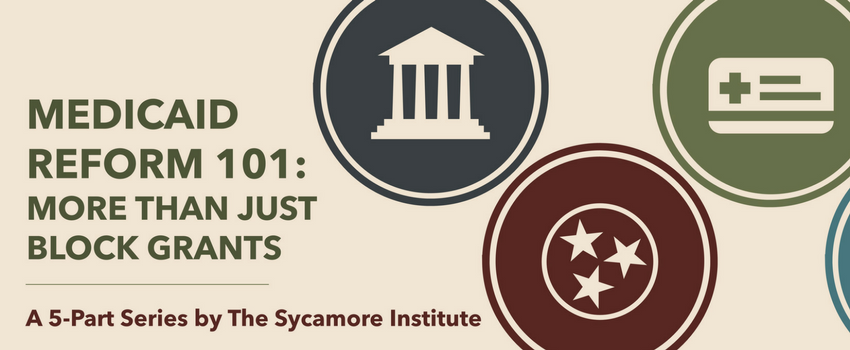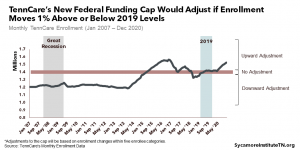
What’s the difference between Medicaid and Medicare? What’s TennCare? Those are just three of the Medicaid terms to know as federal and Tennessee lawmakers consider reforms to the program. This glossary supplements our 5-part series Medicaid Reform 101: More Than Just Block Grants. Click here to download the glossary as a PDF.
Glossary of Key Medicaid Terms
ACA: Also known as the Affordable Care Act or Obamacare.
AFFORDABLE CARE ACT: Also known as the ACA or Obamacare. The ACA is the law passed by the U.S. Congress in 2010, which made significant changes to the individual health insurance market. In the context of Medicaid, it also included a new eligibility category for state Medicaid programs – allowing states to receive an enhanced FMAP to cover all adults with incomes up to 138% of the federal poverty line (FPL) not already eligible for Medicaid.
ALLOTMENT: In the context of Medicaid reform, a general term for a designated amount of federal funds available for state spending. For example, a federal allotment could take the form of a block grant or could be determined by multiplying a per capita cap by total enrollment.
AT-RISK: In the context of Medicaid managed care, also known as capitated or PMPM payments. The term refers to the risk that MCOs take on to keep enrollees’ costs within the payment rates provided.
BLOCK GRANT: A lump sum of money provided by the federal government to state governments for a broad purpose. In the context of Medicaid reform, a block grant would provide a single federal grant for all Medicaid activities. Funding to Tennessee under a block grant would only change from year to year based on some growth factor and not based on changes in enrollment.
CAPPED ALLOTMENT: In the context of Medicaid reform, a capped allotment would be similar to a block grant in that the maximum allotment available to a state would change based on some growth factor and not based on changes in enrollment. However, the total amount a state could actually spend from the capped allotment could be based on enrollment or tied to some matching requirement.
CAP: Generally, a limit on federal funds available for state spending. The more specific per capita cap would apply a limit on federal funds available for state spending on a per enrollee basis.
CAPITATED PAYMENT: In the context of Medicaid managed care, also known as a PMPM or at-risk payment. Under a capitated payment, Medicaid MCOs receive a single lump-sum payment for each enrollee to cover all the health care needs of that enrollee. The payment is based on data of MCOs’ actual health care costs in prior years for enrollees and is adjusted based on enrollee characteristics that would drive health care needs (e.g. age, gender, disability status). MCOs are responsible – or “at-risk” – for any differences between the payment and actual health care costs, whether they are profits or losses. This provides an incentive for MCOs to manage enrollees’ costs.
CHILDREN’S HEALTH INSURANCE PROGRAM: Also known as CHIP. CHIP is a companion program to Medicaid (sometimes administered separately and sometimes integrated into Medicaid programs) which allows states to cover uninsured children with incomes too high for Medicaid eligibility. CHIP is administered to states as a capped allotment – with state matching requirements determined by an enhanced FMAP that is about 15 percentage points higher than under the normal Medicaid FMAP. The federal cap each year for overall CHIP spending is defined in law and not pegged to any specific growth factor. Because it is a capped allotment, CHIP is not considered an entitlement, and enrollment can be capped. CHIP also provides states with some design flexibilities related to benefits and cost-sharing that are not allowed under Medicaid.
CHIP: Also known as the Children’s Health Insurance Program.
CMS: The federal Centers for Medicare and Medicaid Services within the U.S. Department of Health and Human Services (HHS), which administer both Medicare and Medicaid at the federal level.
CONSUMER-DIRECTED HEALTH CARE: A general term often used to refer to insurance plans or structures that may require enrollees to be more exposed to health care costs or to pay for many costs out of pocket (i.e. cost-sharing). Proponents of these structures argue that they create financial incentives for enrollees to be more thoughtful and invested in using health care and choosing health care providers.
COST-SHARING: Refers to an insurance enrollee’s responsibilities to share the insurer’s cost of providing health insurance. Cost-sharing usually takes the form of deductibles, co-pays, and/or coinsurance. In the context of Medicaid reform, cost-sharing requirements can be met with either an enrollees’ own money or with subsidies.
Under a deductible, an enrollee is responsible for paying for a certain amount of care out of pocket before health insurance coverage kicks in. For example, if a plan has a $2,000 deductible, an enrollee would be required to pay for the first $2,000 worth of care and/or prescriptions they receive before the insurance plan would begin paying providers on the enrollee’s behalf. Many refer to plans with a high deductible as a catastrophic plan, because an enrollee would be responsible for paying for most of their health care needs unless something catastrophic and costly happened.
Under co-pays, once any deductible have been met, enrollees are required to pay a set fee for the use of certain kinds of health care or for prescription drugs regardless of the underlying price. Continuing the example above, once an enrollee has paid for the first $2,000 worth of care they receive, they may then be required to pay $10 out of pocket for each visit to the doctor, $10 for each brand name drug, or $5 for each generic drug, and the insurance company will pick up the rest of the bill.
Coinsurance is similar to co-pays but vary based on the cost of the care or prescriptions received. For example, once the deductible is met, an enrollee may be required to pay 10% of the cost of any doctor’s visit, and the insurance company will pay the remaining 90%.
ELIGIBILITY: In the context of Medicaid, eligibility refers to the criteria that determines whether someone may receive health insurance coverage under Medicaid. Although people will often refer to Medicaid as a health insurance program for low-income individuals, eligibility is far more complicated than that. For that reason, people often refer to Medicaid eligibility based on various categories (or “eligibility categories”), but the categorizations that people use may change based on the context of the discussion.
For example, people may distinguish between mandatory and optional eligibility categories, which refers to whether or not eligibility is required under federal rules or whether it is optional for states. Because some categories are mandatory and some optional, eligibility for Medicaid varies greatly by state. Some of the federal mandatory and optional eligibility categories are outlined below.
Mandatory eligibility for:
- Children up to age 19 and pregnant women with family incomes at or below 133% of the federal poverty limit (FPL)
- Infants born to pregnant women eligible for Medicaid
- Children and certain adults who would be eligible for cash assistance under the welfare rules that were in effect in July 1996
- Children and certain adults with incomes below 185% of FPL in families that are leaving welfare for work
- Children in foster care or an adoption assistance programs
- Elderly individuals and individuals with disabilities that receive cash benefits under Supplemental Security Income (SSI) (The income limit for SSI is around 75% of FPL.)
Optional eligibility for:
- Children, families, and pregnant women with incomes higher than the limits above
- Elderly individuals and individuals with disabilities whose incomes are less than the FPL but who do not receive SSI
- Certain severely impaired individuals who are working but make too much for SSI
- Individuals with disabilities whose incomes are under 250% FPL and are working
- All individuals under 65 with incomes under 138% of FPL not otherwise eligible
The various groups eligible for Medicaid are also sometimes divvied up by the federal government between “categorically needy” and “medically needy.” Categorically needy refers to classes of individuals who are categorically eligible because they are eligible for and/or enrolled in some other program (e.g. welfare or SSI). Medically needy refers to individuals who may be eligible based on a combination of their income and some health need (e.g. low-income pregnant women).
Many refer to the optional eligibility category added by the ACA for all individuals under 65 with incomes under 138% of FPL as the “expansion population.”
Finally, per capita cap proposals often refer to 4 categories: aged, disabled, adults, and children. Although these loosely align with eligibility criteria, these 4 categories also align with different cost profiles. That is, disabled enrollees often cost Medicaid programs the most, with elderly individuals next, then adults, and then children.
ENHANCED FMAP: An enhanced FMAP provides additional federal funds to states above what would normally be provided under a state’s FMAP. Enhanced FMAPs have taken the form of a percentage add-on for all Medicaid costs or as a special FMAP for specific eligibility categories or kinds of spending. Enhanced FMAPs can be used as a tool by the federal government to encourage certain types of spending or eligibility expansions by states or to help defray state costs during economic downturns. For example, during the Great Recession (2007-2009), Congress added a temporary 6.2 percentage point increase onto each state’s FMAP – allowing the federal government to pick up a larger share of the tab of Medicaid costs during this period when Medicaid enrollment was up and state revenue collections were down. The ACA also included an enhanced FMAP for the Medicaid expansion population – limiting any state’s share of costs for this population to 10% beginning in 2017.
ENTITLEMENT PROGRAM: Refers to federal programs that guarantee benefits to a certain group based on eligibility criteria. Medicaid is an entitlement program because all who meet mandatory eligibility criteria are eligible to enroll and receive all covered benefits. As a result, spending on the program – by both the federal and state governments – is tied to enrollment and the utilization of health care by all who are enrolled. As such, entitlements are not subject to spending caps, and enrollment in entitlement programs is not limited.
FEE-FOR-SERVICE MEDICAID: Also known as traditional Medicaid.
FLEXIBILITIES: In the context of Medicaid reform, refers to giving states new legal authority to determine their own eligibility categories, benefit structures, and enrollee requirements for their Medicaid programs. This could include allowing states to apply limits or restrictions on eligibility and/or benefits or placing new requirements on enrollees not currently allowed under current federal law. For example, a design flexibility could be used to allow states to eliminate eligibility for a population currently required to be covered by federal law or to allow states to require cost-sharing from some or all enrollees for accessing certain benefits.
FMAP: Also known as the federal medical assistance percentage. The FMAP varies based on state and determines the percentage of a state’s Medicaid costs that will be covered by the federal government. The remaining portion is the state’s matching requirement. The FMAP for each state is calculated each year based on the state’s per capita personal income compared to the national per capita income average. No state’s FMAP can be less than 50%. Tennessee’s is usually around 65% – leaving 35% as the state’s matching requirement.
The FMAP is also used to determine matching requirements for other non-Medicaid programs – including federal funding for certain child care programs, foster care, and adoption assistance.
FPL: Also known as the federal poverty limit. In 2016, the FPL for an individual was $11,880 per year. For a family of 2, $16,020. For a family of 3, $20,160. For a family of 4, $24,300.
GROWTH FACTOR: In the context of Medicaid reform, growth factor refers to the rate at which the cap on federal funds for a state’s Medicaid costs would grow from year to year. The growth factor could apply to a block grant, a per capita cap, or a capped allotment. Some potential growth factors that have been discussed include inflation (i.e. the growth in prices), the gross domestic product (GDP) (i.e. the growth in the U.S. economy), or per capita GDP (i.e. the growth in the U.S. economy and population).
HMO: Also known as a Health Maintenance Organization. HMOs are a certain type of private health insurance company – including MCOs – that use a managed care approach.
MANAGED CARE: Generally, managed care is an approach used by private health insurance companies to manage the costs of their enrollees. For example, an insurance company may limit enrollees to use only “in-network” providers with which insurers have negotiated a discounted payment rate. In the context of Medicaid, managed care is an approach used by many states, including Tennessee, in which the state Medicaid program contracts with MCOs to administer benefits to enrollees in exchange for an at-risk capitated payment. Many Medicaid managed care programs need a waiver to operate.
MANAGED CARE ORGANIZATION: Also known as an MCO. In the context of Medicaid managed care, MCOs are private health insurance companies that administer and manage the benefits of Medicaid enrollees in exchange for an at-risk capitated payment. TennCare uses MCOs to administer Medicaid benefits — including BlueCross BlueShield of Tennessee, Amerigroup, and UnitedHealthcare.
MCO: Also known as Managed Care Organizations.
MATCHING REQUIREMENT: Requirement for states to contribute a certain amount of funding for federally funded activities. For example, states may be required to contribute $0.50 for every $1 provided by the federal government. In the context of Medicaid, the FMAP determines the state Medicaid matching requirement under which Tennessee is required to cover about 35% of most costs related to TennCare.
MAINTENANCE OF EFFORT REQUIREMENT: Requirement for states to maintain either a certain level of funding or certain eligibility or benefits criteria in exchange for federal funding. For example, under certain programs, states cannot reduce their spending on a federally-funded activity below their spending in a certain year even if the lower level of state spending meets a matching requirement.
MEDICAID: First established in 1965, Medicaid is a health insurance program largely targeted at certain low-income individuals who are over age 65, have a disability, are mothers, are pregnant, or are children. The program is jointly funded by federal and state governments (as determined by the FMAP) and is administered by states within certain federal parameters for eligibility and benefits. Because eligibility, benefits, and requirements vary by all 50 states, references to Medicaid includes terms like “state Medicaid programs” or state-specific program names. Tennessee’s Medicaid program is TennCare.
MEDICAID EXPANSION: Refers to the optional Medicaid eligibility expansion in the ACA – allowing states to receive an enhanced FMAP for providing Medicaid coverage to individuals under 65 with incomes under 138% of the federal poverty limit (FPL) not otherwise eligible for Medicaid.
MEDICARE: Established in 1965, Medicare is a health insurance program for all individuals over age 65, certain younger individuals with disabilities, and individuals with permanent kidney failure. Medicare is administered by and exclusively funded by the federal government. If a Medicare enrollee has a low income, they may also be eligible for Medicaid. These individuals are known as “dual eligible” (or simply “duals”), and both states and the federal government share the costs of covering the cost-sharing requirements of Medicare and any benefits covered by Medicaid but not Medicare.
OBAMACARE: Also known as the ACA or the Affordable Care Act.
PER CAPITA CAP: In the context of Medicaid reform, per capita caps would provide a capped payment to state Medicaid programs for each Medicaid enrollee. The caps could vary based on eligibility categories, but each state’s overall allotment under a per capita cap would change year to year based on some growth factor and enrollment.
PMPM: In the context of Medicaid managed care, also known as at-risk or capitated payments. PMPM stands for “per member per month,” because payments to MCOs are made on a monthly basis for each enrollee.
SUBSIDIES: In the context of Medicaid reform, subsidies refer to financial assistance provided to enrollees to help defray cost-sharing requirements or requirements to pay premiums for Medicaid coverage. The amount of subsidy can vary based on enrollee characteristics like income or age and can be structured to create incentives for certain behaviors or choices – for example, providing bigger subsidies for enrollees that participate in a wellness program or choose a certain kind of health plan.
TENNCARE: TennCare is Tennessee’s Medicaid program. It operates under a waiver as a Medicaid managed care program, under which all TennCare enrollees receive care from MCOs. As a result, TennCare is sometimes referred to as “Tennessee’s waiver program.” TennCare is managed by the Division of Health Care Finance & Administration within the Tennessee Department of Finance & Administration – sometimes referred to as the TennCare Bureau.
TRADITIONAL MEDICAID: Also known as fee-for-service Medicaid. Under traditional Medicaid, benefits are administered by the state, and payments are made directly by the state to any health care providers wishing to participate in the program based on a fee schedule. This is in contrast to managed care, under which private health insurance companies receive capitated payments from the state to manage the costs of enrollees through cost-savings practices like limited provider networks. In most cases, waivers are not necessary to operate traditional Medicaid programs.
WAIVER: The law establishing Medicaid – the Social Security Act – provides opportunities for CMS to waive certain federal rules if states have ideas for better managing their programs. When states seek to waive these rules, they do so through a waiver. For example, a state may want a waiver from rules that bar all enrollees from being automatically enrolled in an MCO. Or a state may have an idea for waiving certain benefit rules that might generate enough savings to expand eligibility to new populations within existing funding levels.
Waivers, however, are time-limited and must be reapproved periodically by CMS – usually about every 5 years. The waiver approval process isn’t laid out in law and isn’t always transparent. The waiver authority is also still relatively narrow – meaning that it does not provide unlimited flexibility to states to change eligibility, benefits, and enrollee requirements. TennCare is operated through a waiver.

















